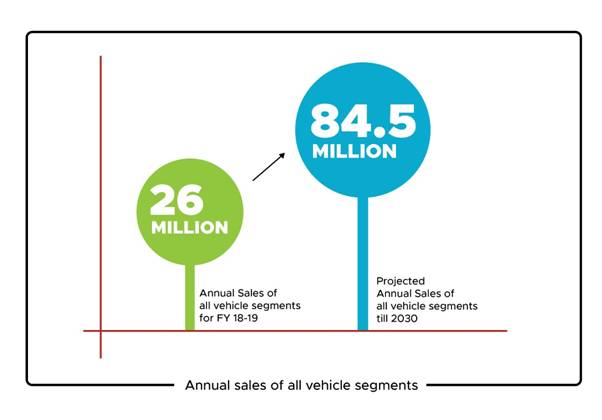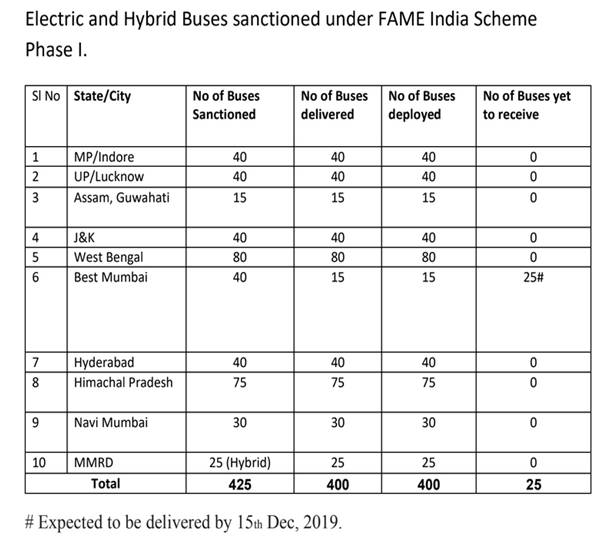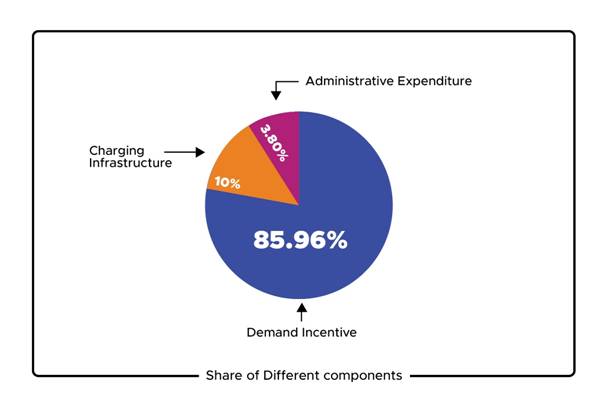Ministry of Heavy Industries
Year Ender 2019 Ministry of Heavy Industry
Second Phase of the Fame India Scheme Commenced From 1st april 2019
Outlay of Rs. 10,000 crore for 3 years under fame-II
5595 e-Buses to 64 Cities in 26 States under Fame-II
प्रविष्टि तिथि:
20 DEC 2019 6:04PM by PIB Delhi
The automobile industry is one of the key drivers of the Indian economy. Since the liberalization of the sector in 1991 by way of allowing 100 percent FDI through automatic route, Indian automobile sector has come a long way. Today, there is a presence of almost every global auto manufacturer in the country. All categories of vehicles like two-wheeler, three-wheeler, passenger cars, light commercial vehicles, Trucks, Buses, Tractors and heavy Commercial vehicles are produced in the country. India is the largest manufacturer of 2W and 3W and 4th largest manufacturers of passenger cars in the world. Total turnover of the Indian Automobile Industry during 2018-19 was about 118 Billion USD (Rs 8.2 Lakh Crore), which constitutes 7.1% of the country’s total GDP, 27% of Industrial GDP and 49% of Manufacturing GDP. This industry is one of the largest employers and provides about 37 million direct and indirect jobs. The current annual sale of vehicles of all categories is about 26 million (2018-19) which is slated to increase by more than 3 times to about 84.5 million by 2030.

Import of crude oil to the tune of billions of liter per year and associated emission of millions tons of CO2 and other pollutants are some of the main challenge being faced by the country which is directly related to Automobile sector. Presently, India is facing an acute air pollution crisis and 14 of the top 20 most polluted cities in the world are in India.
To address these challenges, different stakeholder departments of the Government are devising strategies like tightening of CAFÉ Norms, introduction of BS VI compliant vehicles by leapfrogging from BS IV to BS VI directly, Fuel efficiency norms for heavy duty commercial vehicles, Start rating for the vehicles and so on. Promotion of Electric Mobility, which has Zero Tail pipe emission is an efforts of the government in this direction to reduce oil dependency and also to reduce vehicular pollution from the cities.
Embracingelectric mobility on large scale is imperative to tackle the various crisis arising due to pollution and giving the citizens of India a better quality of life.
Electric & Hybrid Mobility:
Government of India approved the National Mission on Electric Mobility (NMEM) in 2011 and subsequently National Electric Mobility Mission Plan 2020 (NEMMP 2020) was unveiled in 2013 by the Prime Minister.
The NEMMP 2020 is a National Mission document providing the vision and the roadmap for the faster adoption of electric vehicles and their manufacturing in the country. This plan has been designed to enhance national fuel security, to provide affordable and environmentally friendly transportation and to enable the Indian automotive industry to achieve global manufacturing leadership. It is one of the most important and ambitious initiatives undertaken by the Government of India that has the potential to bring about a transformational paradigm shift in the automotive and transportation industry in the country. This plan was a culmination of a comprehensive collaborative planning for promotion of hybrid and electric mobility in India through a combination of policies aimed at gradually ensuring a vehicle population of about 6-7 million electric/hybrid vehicles in India by the year 2020 along with a certain level of indigenisation of technology ensuring India’s global leadership in some vehicle segments.
As part of the NEMMP 2020, the Government approved the scheme titled ‘Faster Adoption and Manufacturing of Electric (&Hybrid) Vehicles in India’ (FAME India) in March, 2015 for an initial period of 2 years from 01stApril, 2015 with an aim to reduce dependency on fossil fuel and to address issues of vehicular emissions. The Scheme has been extendedfrom time to time till 31st March, 2019 with total outlay to Rs. 895 crore. The 1st Phase of FAME India Scheme was implemented through four focus areas namely (i) Demand Creation, (ii) Technology Platform, (iii) Pilot Project and (iv) Charging Infrastructure.

Demand creation is aimed at incentivizing the buyers of xEVsthrough providing demand incentives, leading to an upfront reduced purchase price at the time of purchase of vehicle at dealer level. The component of pilot projects envisaged trial of new technologies, business models etc. with special focus on public transportation. The technology platform under the scheme has been under execution in tandem with theDepartment of Science and Technology (DST) where PPP projects for development of EV (Electric Vehicle) technologies have been approved. Charging Infrastructure component envisages installation of charging station in different cities depending upon the uptake of electric vehicles in the country.

Achievements under Phase-1 of FAME India scheme:
Although the FAME Scheme was described as pilot scheme at the time of sanction before consideration of main scheme as envisage in NEMMP 2020, this scheme was very successful in creating the major policy discourse on Electric Mobility among all stakeholders including different departments of Government of India and State Governments.
Some of the quantitative and qualitative success of this scheme is as given below.
In this Phase of the Scheme about 2.8 lakh hybrid and electric vehicles are supported by way of demand incentive amounting to about Rs 359 crore resulting in saving of about 50 million liters of fuel and reduction of about 124 million Kg of CO2.
Projects worth about Rs. 158 Crores are sanctioned for the technology development projects like establishment of testing Infrastructure, setting up of ‘Centre of Excellence’ for Advanced Research in electrified transportation, Battery Engineering etc. to various organisations / institutions like Automotive Research Association of India (ARAI), IIT Madras, IIT Kanpur, Non Ferrous Material Technology Development Centre (NFTDC) and Aligarh Muslim University (AMU).
Under this scheme, DHI has sanctioned 425 electric and hybrid buses to various cities in the country with total cost of about 300 Crores. Out of 425 e-buses, 400 are received and deployed in various cities such as Indore, Lucknow, Guwahati, J&K, Kolkata, Hyderabad, Shimla andMumbai. Remaining 25 no of e-buses at Mumbai are expected to be deployed by end of this month.
Under charging infrastructure, Government of India has sanctioned about 500 charging stations / infrastructure in cities like Bangalore, Chandigarh, Jaipur and NCR of Delhi. Department of Heavy Industry also entrusted the task of making three expressways fully E-vehicle friendly by way of establishment of charging infrastructure at regular intervals to its public sector undertakings like BHEL and REIL. These highways are Delhi-Chandigarh, Delhi-Jaipur and Mumbai-Pune Expressways. Out of these recently Delhi – Chandigarh highway is declared as first expressway of the country which is E-vehicle friendly expressway.
FAME India Scheme Phase II:
Based on the outcome and experience of the FAME India Scheme, the second Phase of FAME Scheme was finalised and notified on 8thMarch 2019 with the approval of Union Cabinet. Second phase of thescheme commenced from 1st April 2019 with an outlay of Rs. 10,000 Crorefor a period of 3 years. This scheme has 3 components. namely –
a) Demand Incentives:
b) Charging Infrastructures:
c) Administrative Expenditure including Publicity, IEC Activities:
Salient features of FAME India Scheme Phase II:
This phase aims to generate demand by way of supporting 7090 e-Buses, 5 lakh e-3 Wheelers, 55000 e-4 Wheeler Passenger Cars (including Strong Hybrid) and 10 lakh e-2 Wheelers.
With greater emphasis on providing affordable &environment friendly public transportation options for the masses, the scheme will be applicable mainly to vehicles used for public transport or those registered for commercial purposes for all segment of vehicles.
For e-2W segment, this scheme is also applicable to privately owned registered e-2W also.
Depending upon offtake of different category of e-Vehicles, the provision has been made in the scheme for inter as well as intra segment wise fungibility.
Scheme is applicable to only those xEVs, which is fitted with advanced chemistry battery.
Scheme is applicable to only those vehicles, which is defined as Motor Vehicle as per CMVR and eligible to registered with Road Transport Authority.
In this phase, the demand incentive is linked to battery capacity i.e. Rs. 10,000/KWh for all eligible Vehicles except e-Buses (for which the incentive is Rs. 20,000/KWh), subject to capping at certain percentage of cost of eligible Vehicles [i.e. 40% for e-Bus and at 20% for all other categories of eligible Vehicle].
Demand incentive is extended to only those vehicles having ex-factory prices less than the threshold value.
Further, keeping in view market and technology trends in batteries, a provision has been made for revision of demand incentives from time to time under the scheme.
The incentive is applicable to vehicles manufactured in India as per phase manufacturing program issued by the department. Only OEMs which have achieved 40% localization level in case of 4W and Buses and 50% localization in case of 2W and 3W are only eligible to get incentives.
Performance under FAME India scheme Phase II:
OEMs and Vehicle Models: So far, 13 OEMs have registered their 39 EV Models [2W= 14; 3W=11 & 4W=14] for availing benefit of demand incentives under Phase-II of FAME Scheme. So far about 5500 EVs have been sold to the eligible user of the electric vehicle.
Sanction of Electric Buses: In order to promote electric mobility in public transport, Department has invited the proposal from cities and state transport corporations through an Expression of Interest for deployment of Electric Buses under Operation cost model basis. After examining the proposal department has sanctioned of 5595 no of e-buses to 64 cities for intra-city and intercity operations across 26 states/UT under the Scheme. These buses will runabout 4 billion Kilometer distance during their contract periodand are expected to save cumulatively about 1.2 billion litersof fuel over the contract period, which will result into avoidance of 2.6 million tonnes of CO2 emission.
Sanction of Charging Infrastructure: To address the issue of range anxiety, department has issued an Expression of Interest (EoI) inviting Proposals from Urban Local Bodies (ULBs)/municipal corporations, PSUs (State/Central) and public/private entities desirous for deployment of EV charging infrastructure in different states/cities for availing incentives under Fame India Scheme Phase II. About 100 proposals are received in response to the EoI for deployment of about 7000 charging stations in above cities. All proposals are under examination and sanction of charging station across the cities will be issued shortly.
Other initiatives to promote Electric Mobility:
In addition to FAME India scheme Phase II, different wings of Government is working to promote electric mobility in the country. Some of the major action in this regards are as given below.
GST on EVs is reduced to 5% from the current rate of 12%.
Government has extended an additional income tax deduction of Rs 1.5 Lakh on interest paid on loans to the buyers of Electric Vehicle to buy EVs is provided.
Ministry of Power has allowed sale of electricity as ‘service’ for charging of electric vehicles. This would serve as an incentive to attract investments into charging infrastructure.
Ministry of Road Transport Highways (MoRTH) issued notification regarding exemption of permit in case of battery operated commercial vehicles.
MoRTH has issued a notification for Green Number plate for the use of Electric Vehicles.
Ministry of Finance has revised the custom duty on the EV components to promote local manufacturing of these components.
Challenges faced in wider adoption of EVs
(i) Lack of awareness among people
(ii) Range anxiety
(iii) High capital cost of EVs as compared to ICE vehicle
(iv) Sub-Par performance of EVs as compared to ICE vehicle
(v) Recycling of battery
Way Forward:
Government is working on following initiatives to promote electric mobility.
Sanction of about 1000 charging stations in various cities in response to Expression of Interest issued by Department of Heavy Industry
Issue of fresh Expression of Interest for inviting proposals fromeligible public entities for installation of charging infrastructure on major identified highways.
Monitoring timely deployment of 5595 electric buses sanctioned under the schemes to 64 cities and eight State Transport corporations.
Publicity activities to promote public to adopt electric mobility.
Issue of fresh EOI for sanction of additional buses to the states/cities for intra city and intercity operations.
Department of Public Enterprises
Government of India is granted Maharatna status to Power Grid Corporation of India limited and Hindustan Petroleum Corporation limited which will enable the Boards of these CPSEs to exercise greater Financial and operational powers and facilitate expansion of operation in the global market.
Bharat Heavy Electricals Limited(BHEL), a Maharatnacompany
BHEL took the following initiatives of Commissioning India’s first Lithium-ion based Space Grade Cell manufacturing facility at BHEL Bengaluru, utilizing technology developed by ISRO. It also commissioned manufacturing facilities for gates & dampers to meet emission norms for coal-based power plants.
BHEL supplied special Tanks, Rigs, Batteries and Solar Panels for ISRO’S Chandrayaan modules a significant contribution by the company in the space programme of the country.
For the first time BHEL received order for 25 nos of 5000 HP electric locos (WAG-7 type) with regenerative braking system from Indian Railways.
DPE is monitoring the capital expenditure (CAPEX) by CPSEs & other Government organizations where target is more than Rs. 500 crore. This has resulted in better spending for infrastructure projects by the CPSEs and other Government organizations. The CAPEX achievement of these organizations has increased to Rs. 2,05,368 crore in first six months of 2019-20 as compared to Rs. 1,94,331 crore in first half of previous year (increase of 5.69%). CAPEX review meetings have been conducted on 03.09.2019 and 05.09.2019 in respect of 16 CPSEs.
***
MM/ SB
(रिलीज़ आईडी: 1597099)
आगंतुक पटल : 1596